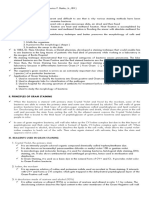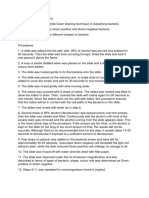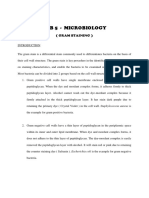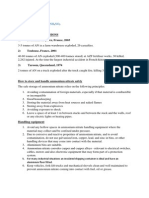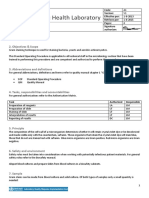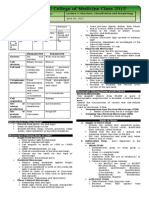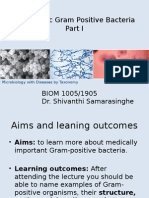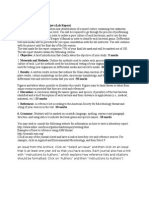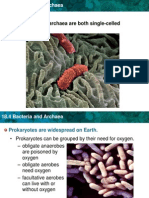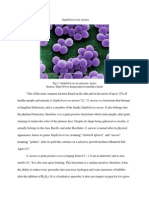0 ratings0% found this document useful (0 votes)
171 viewsLab 3
Lab 3
Uploaded by
Diyana Nabila Abdul WahidThis document describes an experiment to perform gram staining on Bacillus sp. and an unknown bacteria. Gram staining allows differentiation of bacteria as either gram-positive or gram-negative based on their ability to retain or lose crystal violet dye when exposed to alcohol and iodine. The results showed that Bacillus sp. was gram-positive, appearing purple under the microscope due to retention of crystal violet. The unknown bacteria was gram-negative, appearing red due to loss of crystal violet and uptake of the safranin counterstain. The differences in staining are due to variations in peptidoglycan thickness and structure in bacterial cell walls.
Copyright:
© All Rights Reserved
Available Formats
Download as DOCX, PDF, TXT or read online from Scribd
Lab 3
Lab 3
Uploaded by
Diyana Nabila Abdul Wahid0 ratings0% found this document useful (0 votes)
171 views6 pagesThis document describes an experiment to perform gram staining on Bacillus sp. and an unknown bacteria. Gram staining allows differentiation of bacteria as either gram-positive or gram-negative based on their ability to retain or lose crystal violet dye when exposed to alcohol and iodine. The results showed that Bacillus sp. was gram-positive, appearing purple under the microscope due to retention of crystal violet. The unknown bacteria was gram-negative, appearing red due to loss of crystal violet and uptake of the safranin counterstain. The differences in staining are due to variations in peptidoglycan thickness and structure in bacterial cell walls.
Original Description:
lab
Original Title
LAB 3
Copyright
© © All Rights Reserved
Available Formats
DOCX, PDF, TXT or read online from Scribd
Share this document
Did you find this document useful?
Is this content inappropriate?
This document describes an experiment to perform gram staining on Bacillus sp. and an unknown bacteria. Gram staining allows differentiation of bacteria as either gram-positive or gram-negative based on their ability to retain or lose crystal violet dye when exposed to alcohol and iodine. The results showed that Bacillus sp. was gram-positive, appearing purple under the microscope due to retention of crystal violet. The unknown bacteria was gram-negative, appearing red due to loss of crystal violet and uptake of the safranin counterstain. The differences in staining are due to variations in peptidoglycan thickness and structure in bacterial cell walls.
Copyright:
© All Rights Reserved
Available Formats
Download as DOCX, PDF, TXT or read online from Scribd
Download as docx, pdf, or txt
0 ratings0% found this document useful (0 votes)
171 views6 pagesLab 3
Lab 3
Uploaded by
Diyana Nabila Abdul WahidThis document describes an experiment to perform gram staining on Bacillus sp. and an unknown bacteria. Gram staining allows differentiation of bacteria as either gram-positive or gram-negative based on their ability to retain or lose crystal violet dye when exposed to alcohol and iodine. The results showed that Bacillus sp. was gram-positive, appearing purple under the microscope due to retention of crystal violet. The unknown bacteria was gram-negative, appearing red due to loss of crystal violet and uptake of the safranin counterstain. The differences in staining are due to variations in peptidoglycan thickness and structure in bacterial cell walls.
Copyright:
© All Rights Reserved
Available Formats
Download as DOCX, PDF, TXT or read online from Scribd
Download as docx, pdf, or txt
You are on page 1of 6
ABSTRACT
Staining is a technique used in microscopic techniques to enhance the clarity of the
microscopic image and in this experiment, we are using Bacillus sp. and unknown bacteria.
In gram staining we have to determine the gram of the bacteria either it is gram-positive or
gram-negative. The smear first was flooded with crystal violet and excess dye was washed
with tap water and let it dry. After that, the smear was exposed to iodine, 95% alcohol and
lastly 0.25% safranin. The smear must be washed with tap water and let it dry before putting
the next reagent. Then, the smear was observed under the microscope and we get for Bacillus
sp. it is gram-positive because it shows purple color and the shape is bacillus. While for
unknown bacteria is gram-negative because it shows red color and the shape is coccus.
INTRODUCTION
Stains and dyes are widely used in the scientific field to highlight the structure
of the biological specimens, cells and tissue. The most widely used staining procedure in
microbiology is the Gram stain, discovered by the Danish scientist and physician Hans
Christian Joachim Gram in 1884. Gram staining is a differential staining technique that
differentiates bacteria into two groups: gram-positives and gram-negatives. The procedure is
based on the ability of microorganisms to retain color of the stains used during the gram stain
reaction. Gram-negative bacteria are decolorized by the alcohol, losing the color of the
primary stain, purple. Gram-positive bacteria are not decolorized by alcohol and will remain
as purple. After decolourizations step, a counterstain is used to impart a pink color to the
decolorized gram-negative organisms (Tan, 2013).
The Gram stain is a very important preliminary step in the initial characterization and
classification of bacteria. It is also a key procedure in the identification of bacteria based on
staining characteristics, enabling the bacteria to be examined using a light microscope. The
bacteria present in an unstained smear are invisible when viewed using a light microscope.
Once stained, the morphology and arrangement of the bacteria may be observed as well.
AIMS
1. To develop the skill in preparing slides.
2. To expose the students with the method for differentiation of bacteria types.
THEORY
The Gram stain is a differential stain which allows most bacteria to be divided into
two groups that are gram-positive and gram-negative. The technique is based on the fact that
the gram-positive cell wall has a stronger attraction for crystal violet when Grams iodine is
applied than does the gram-negative cell wall. Grams iodine is known as a mordant. It is able
to form a complex with crystal violet that is attached more tightly to the gram-positive cell
wall than to the gram-negative cell wall. This complex can easily be washed away from the
gram-negative cell wall with alcohol. Gram-positive bacteria, however are able to retain the
crystal violet and therefore will remain purple after decolorizing with alcohol. Since gram-
negative bacteria will be colorless after decolorizing with alcohol, counterstaining with
safranin will make them appear pink (Benjamin, 2013).
The peptidoglycan that present in the cell wall is the main part in order to determine
the gram-positive and gram-negative. Because even though peptidoglycan present in both
bacteria but the arrangement of the peptidoglycan contribute to the classification of the gram-
positive and gram-negative of the bacteria. The gram-positive has a thick peptidoglycan
while the gram-negative has a thin peptidoglycan.
Figure 1 : The cell wall structure of Gram-positive and Gram-negative
Bacteria is vary in their morphology features the most common morphologies are
coccus, rod-shaped bacteria that is generally occur singly and lastly is spirillum that is spiral-
shaped bacteria. Bacillus sp. is known has a rod-shaped.
Figure 2: The morphology of bacteria
APPRATUS AND MATERIALS
1. Glass slide 9. Iodine
2. Dropper 10. Crystal violet
3. Microscope 11. Cloth or tissue
4. Bunsen burner 12. 95% alcohol
5. Bacillus sp.
6. Unknown bacteria
7. 0.25% Safranin
8. Distilled water
PROCEDURE
A. Preparation of Cell Smear
1. The slide was cleaned for the preparation of smeared with water or scouring powder.
2. After the cleaning of slide, it rinsed using water and 95% of alcohol.
3. Slide was dried and placed on laboratory towels.
4. The smear was prepared using dropper. Avoid thick and dense smear because this will
reduce the amount of light.
5. The slide was heat using Bunsen burner, by forming rapid passage two or three times.
B. Simple Staining
1. The slide was placed on the staining tray and the smear was flooded with one
indicated stains, with appropriate exposure time for each : Carbon fuchsin 15-30
seconds, crystal violet 20-60 seconds, methylene blue 1-2 minutes.
2. Smear slide was gently washed with tap water to remove excess stain. The slide was
hold parallel to the stream of water in order to reduce the loss of organisms from the
preparation.
3. The smear was bolted using bibulous but not to wipe the slide.
4. The slide was examined using oil immersion microscope.
C. Gram Stain
Slant Cultures
1. The slide was smear and undergo heat fixation.
2. Crystal violet was flooded for one minute.
3. Excess dye was washed gently with tap water and dried the slide using paper towel.
4. The smear was exposed to grams iodine for one minute by washing with iodine, then
adding more iodine and leaving it on smear until one minute is over.
5. The smear was washed with tap water and drained carefully.
6. Then, smear was washed with 95% of alcohol for 30 seconds.
7. After that, the smear was washed with tap water at the end of the 30 seconds to stop
the decolorization and drained.
8. The smear was counterstain with 0.25% safranin for 30 seconds.
9. The smear was washed, drained, blotted and examined under oil.
10. The cell morphology, group and relative sizes was drew.
Broth Cultures
1. The ring was drew under open slide to mark the area for the smear of the broth since
broth cultures was nearly visible to naked eye.
2. Do not add drop of water to the borth.
3. The smear was heat fixed and gram stain the smear using the above procedure.
4. Slide was examined.
RESULT
A. Gram Staining
Bacillus sp. UNKNOWN
Shape : Bacillus
Arrangement : Cluster
Cell Color : Purple
Gram-positive
Shape : Coccus
Arrangement : Chain
Cell Color : Red
Gram-negative
DISCUSSION
In this experiment we did not do the simple staining because the morphology of the
bacteria can be seen from the gram staining method. From the experiment, it shows that the
Bacillus sp. has a bacillus shape and the arrangement is cluster. The colour of the cell is
purple and this indicate that it is gram-positive. While for the unknown bacteria it shows that
the shape is coccus and the arrangement is chain. The colour of the cell is red and it indicate
that the cell is gram-negative. The gram bacteria shows different color due to the arrangement
of the peptidoglycan in the cell wall. The peptidoglycan that present in the cell wall is the
main part in order to determine the gram-positive and gram-negative.
Crystal violet is the first dye use is gram staining. It forms a complex with iodine and
get fixed permanently in gram-positive bacteria. The dye iodine complex is not washed out
from these organisms and not decolorized. This is because it contain a thick peptidoglycan
while the gram-negative have a thin peptidoglycan. Therefore, the dye is not fixed
permanently in gram-negative bacteria. The gram-negative bacteria will lose the dye and
become colorless while the gram-positive bacteria retain the color of the crystal violet. So
when gram-negative bacteria is stained with 0.25% Safranin, the red color will appear while
for gram-positive will still retain the violet color.
The crystal violet is the primary stain, which stains everything in the smear blue. The
Gram's iodine acts as a mordant and expose it around 1 minute. It is able to form a complex
with crystal violet that is attached more tightly to the gram-positive cell wall than to the
gram-negative cell wall. This complex can easily be washed away from the gram-negative
cell wall with alcohol and in this experiment we are using 95% alcohol. Gram-positive
bacteria, however are able to retain the crystal violet and therefore will remain purple after
decolorizing with alcohol. Since gram-negative bacteria will be colorless after decolorizing
with alcohol, counterstaining with Safranin will make them appear pink. Before putting the
next dye, the smear must first washed with tap water and dried it using paper towel to avoid
the dye is mix with one another.
CONCLUSIONS
In conclusion, the Bacillus sp. is a gram positive bacteria and has a bacillus shape.
While the unknown is a gram-negative bacteria and has a coccus shape. The graam of the
bacteria is determine from the color of the bacteria. The bacillus sp. shows purple color while
the unknown shows red color.
RECOMMENDATIONS
1. Every time dye is use, make sure each dye have appropriate time of exposure to make
sure that there bind with the bacteria cell wall before wash it away.
2. When wash the smear, make sure the slide is parallel with the tap water to avoid the
smear watch out.
3. Dry the slide carefully and lightly with paper towel to prevent from wiping the smear.
REFERENCES
Benjamin, M. (2013). Biologycorner Corporation. Retrieved from Biologycorner web site:
www.biologycorner.com
Tan, S. (2013). Amrita Virtual Lab Collaborative Platform. Retrieved from NME ICT initiative
of MHRD: http://amrita.vlab.co.in/?sub=3&brch=73&sim=208&cnt=1
You might also like
- List of Pressure Vessels Manufacturing in MalaysiaDocument2 pagesList of Pressure Vessels Manufacturing in MalaysiaDiyana Nabila Abdul WahidNo ratings yet
- 4 Microbiology Lab Report Practical 3 PDFDocument10 pages4 Microbiology Lab Report Practical 3 PDFNurul IzzahNo ratings yet
- Microbiology Lab Unknown ReportDocument16 pagesMicrobiology Lab Unknown Reportapi-309431725100% (1)
- Report On Gram Staining 1Document7 pagesReport On Gram Staining 1Abena FlourishingNo ratings yet
- Exp#5 Gram StainingDocument4 pagesExp#5 Gram StainingbahadiroztenNo ratings yet
- Lab 4 Staining and Observation of MicroorganismsDocument9 pagesLab 4 Staining and Observation of MicroorganismsNur NatashaNo ratings yet
- Gram StainDocument7 pagesGram StainYani ManuelNo ratings yet
- MLT 415 Lab Report Gram Stain TechniquesDocument7 pagesMLT 415 Lab Report Gram Stain TechniquesYo YaNo ratings yet
- Gram Staining of BacteriaDocument3 pagesGram Staining of Bacteriadavid5king-3119No ratings yet
- LAB 2: Staining and Streaking: Series of Stains and Chemical Reagents To Increase Contrast and Reveal Information AboutDocument10 pagesLAB 2: Staining and Streaking: Series of Stains and Chemical Reagents To Increase Contrast and Reveal Information AboutrabkaNo ratings yet
- Lab 4 - Staining and Observation of MicroorganismsDocument9 pagesLab 4 - Staining and Observation of MicroorganismsYusof Sundang100% (1)
- Gram StainingDocument2 pagesGram StainingJospes_No ratings yet
- Experiment 5 MIC125Document10 pagesExperiment 5 MIC125Nabila HusnaNo ratings yet
- SBL 1023 Lab 9 Exp Gram Staining AsepticDocument10 pagesSBL 1023 Lab 9 Exp Gram Staining Asepticapi-384057570No ratings yet
- Bacterial Staining TechniquesDocument3 pagesBacterial Staining TechniquesSeerat FatimaNo ratings yet
- Gram StainingDocument3 pagesGram Stainingmike peterNo ratings yet
- Lab Report 3Document5 pagesLab Report 3nurul ainNo ratings yet
- Gram Staining LaboratoryDocument3 pagesGram Staining Laboratorybiancaarabila.loboNo ratings yet
- BI103 Practical 2 HandoutDocument5 pagesBI103 Practical 2 HandoutStephane FongNo ratings yet
- Staining Reaction 16-11-2016-1Document61 pagesStaining Reaction 16-11-2016-1sameera ruffaiNo ratings yet
- Lab Report Bio461 Practical 2 (Discussion & Conclusion)Document4 pagesLab Report Bio461 Practical 2 (Discussion & Conclusion)Allisya NasirNo ratings yet
- Pre Lab7Document5 pagesPre Lab7임성민No ratings yet
- Cell Staining: The Simple StainDocument4 pagesCell Staining: The Simple StainAitlas KhanNo ratings yet
- StainingDocument5 pagesStainingyuppie_raj2175No ratings yet
- Microbiology ExperimentDocument9 pagesMicrobiology Experiment门门No ratings yet
- Experiment 4 MicrobiologyDocument5 pagesExperiment 4 MicrobiologyFrancis TagnongNo ratings yet
- Gram Stain Procedure and Additional Information - Practical 1Document6 pagesGram Stain Procedure and Additional Information - Practical 1kamvajavasNo ratings yet
- Gram Stain MethodsDocument24 pagesGram Stain MethodsRasha MohammadNo ratings yet
- Exp7 Pre-lab report - 최진호 (2016310092)Document5 pagesExp7 Pre-lab report - 최진호 (2016310092)임성민No ratings yet
- Gram Staining:: Gram-Negative Bacteria Such As The Salmonella Typhi That Is Associated With Typhoid Fever. PurposeDocument2 pagesGram Staining:: Gram-Negative Bacteria Such As The Salmonella Typhi That Is Associated With Typhoid Fever. PurposeIravati RayNo ratings yet
- Differential (Gram) Staining L 2111003 - Abhishek.S - B1Document4 pagesDifferential (Gram) Staining L 2111003 - Abhishek.S - B1one2three1two34No ratings yet
- Diversity of BacteriaDocument3 pagesDiversity of BacteriaLisa AllisyaNo ratings yet
- Assignment Gram Stain.111Document6 pagesAssignment Gram Stain.111premium Shopping centreNo ratings yet
- Gram StainingDocument4 pagesGram StainingmaryannekijoNo ratings yet
- Lab 5 - Microbiology: (Gram Staining)Document6 pagesLab 5 - Microbiology: (Gram Staining)api-383698554No ratings yet
- Bio 112 Exp 3 RajnishDocument9 pagesBio 112 Exp 3 RajnishRajnish ShreerajNo ratings yet
- Exp 1Document2 pagesExp 1Dibyajyoti20 Das4001No ratings yet
- Staining TechniquesDocument9 pagesStaining Techniquesjaysand08No ratings yet
- FST-305 Cereal Milling & LegumesDocument2 pagesFST-305 Cereal Milling & LegumesRishav GautamNo ratings yet
- Am StainingDocument6 pagesAm StainingAlison 123 Parajuli 123No ratings yet
- Simple and Differential Staining of Bacteria: Figure1 Principles Behind Gram StainingDocument4 pagesSimple and Differential Staining of Bacteria: Figure1 Principles Behind Gram StainingNurulJazirohNo ratings yet
- Amanda Harris (1037441) - BIO2108 Lab 6Document7 pagesAmanda Harris (1037441) - BIO2108 Lab 6Amanda harrisNo ratings yet
- StainigDocument38 pagesStainigyuppie_raj2175No ratings yet
- Stainning 2019Document29 pagesStainning 2019Almoatazbellah AbdallahNo ratings yet
- Staining Techniques in Microbiology.Document9 pagesStaining Techniques in Microbiology.rajendraprasadreddyNo ratings yet
- Moyes 2009, Tinción de GramDocument8 pagesMoyes 2009, Tinción de GramVale rumazNo ratings yet
- 3.4 Theory: WWW - Uphs.upnn - Edu/bugdrug/antibiotic-Manual/gram/.htmDocument3 pages3.4 Theory: WWW - Uphs.upnn - Edu/bugdrug/antibiotic-Manual/gram/.htmFizaNo ratings yet
- (General Microbiology) Lab Rep 4 - Gram StainingDocument15 pages(General Microbiology) Lab Rep 4 - Gram StainingFrancis MagbitangNo ratings yet
- Gram-Staining LabDocument4 pagesGram-Staining Labapi-419388203No ratings yet
- StainingDocument60 pagesStainingved.g007No ratings yet
- Gram StainingDocument72 pagesGram Stainingtummalapalli venkateswara rao100% (2)
- Gram StainingDocument19 pagesGram StainingkashaffazilatNo ratings yet
- Gram Stain Prac ReportDocument4 pagesGram Stain Prac ReportToga BrandonNo ratings yet
- Worksheet 1 Microscopic Visualization of Bacteria Differential and Structural StainingDocument6 pagesWorksheet 1 Microscopic Visualization of Bacteria Differential and Structural StainingKyra ErniNo ratings yet
- Cell Differentiation by GramDocument4 pagesCell Differentiation by GramSherry Anne Ynciong PanganibanNo ratings yet
- Lab ReportDocument24 pagesLab Reportwol aldo0% (1)
- Gram's Stain ReagentDocument3 pagesGram's Stain Reagentsubhaga dubeyNo ratings yet
- Gram StainDocument4 pagesGram StainАлтыншаш АхметоваNo ratings yet
- Lab Bio 301 - 1Document5 pagesLab Bio 301 - 1Nur AthirahNo ratings yet
- Gram StainingDocument4 pagesGram StainingPuteri Sara mahmud100% (1)
- How to Grow Magic Mushrooms: : Simple Ways to Cultivating Psilocybin Mushrooms (2nd Edition)From EverandHow to Grow Magic Mushrooms: : Simple Ways to Cultivating Psilocybin Mushrooms (2nd Edition)Rating: 2.5 out of 5 stars2.5/5 (3)
- AimsDocument1 pageAimsDiyana Nabila Abdul WahidNo ratings yet
- Protocol 1Document3 pagesProtocol 1Diyana Nabila Abdul WahidNo ratings yet
- Residence time, τ (min) Conversion, X (%) 0.67 81 0.8 82.6 1 84.4 1.33 86.6 2 89.2Document2 pagesResidence time, τ (min) Conversion, X (%) 0.67 81 0.8 82.6 1 84.4 1.33 86.6 2 89.2Diyana Nabila Abdul WahidNo ratings yet
- Theory 1) The Reaction RateDocument3 pagesTheory 1) The Reaction RateDiyana Nabila Abdul WahidNo ratings yet
- Ammonium NitrateDocument2 pagesAmmonium NitrateDiyana Nabila Abdul WahidNo ratings yet
- Methods of Classification and Identifying MicroorganismsDocument3 pagesMethods of Classification and Identifying MicroorganismsBecca TayNo ratings yet
- Unesco - Eolss Sample Chapters: Veterinary BacteriologyDocument6 pagesUnesco - Eolss Sample Chapters: Veterinary BacteriologyGaluh EnggarNo ratings yet
- Microscopy and Differential Staining of BacteriaDocument9 pagesMicroscopy and Differential Staining of BacteriaSasha100% (2)
- Identification of Bacterial PathogensDocument100 pagesIdentification of Bacterial Pathogenstummalapalli venkateswara raoNo ratings yet
- SOP of Gram StainDocument5 pagesSOP of Gram Stainzalam55100% (1)
- Experiment 5 MIC125Document10 pagesExperiment 5 MIC125Nabila HusnaNo ratings yet
- Lecture Notes BacteriologyDocument138 pagesLecture Notes BacteriologyJunalyn Banawe Ocden100% (3)
- Yeast Gram StainDocument8 pagesYeast Gram Staineupheema100% (1)
- Koh String Test PDFDocument3 pagesKoh String Test PDFGema Akbar PriadiNo ratings yet
- MicrobiologyDocument9 pagesMicrobiologyWenxinn JCFNo ratings yet
- Assignment PDFDocument6 pagesAssignment PDFaubrey yangzonNo ratings yet
- Exer 6 Post LabDocument23 pagesExer 6 Post LabJonah Feliza Baradas Mora100% (10)
- Microbiology Lecture 1 - Structure, Classification and MorphologyDocument4 pagesMicrobiology Lecture 1 - Structure, Classification and MorphologyAldwin BagtasNo ratings yet
- Molecular Biology 1-2: Put Together By: Linda Fahlberg-StojanovskaDocument32 pagesMolecular Biology 1-2: Put Together By: Linda Fahlberg-StojanovskaLinda Fahlberg-StojanovskaNo ratings yet
- Clin-Tech Microbiology BrochureDocument10 pagesClin-Tech Microbiology Brochurehoria96No ratings yet
- Lab 6 - Survey of MicroorganismDocument6 pagesLab 6 - Survey of MicroorganismYusof SundangNo ratings yet
- Pathogenic Gram Positive BacteriaDocument34 pagesPathogenic Gram Positive BacteriaFahimRazmandehNo ratings yet
- A Guide To Wastewater MicrobiologyDocument14 pagesA Guide To Wastewater Microbiologyabduyassin8014No ratings yet
- MCB 1000LDocument23 pagesMCB 1000Lعبدالجبار عبداللهNo ratings yet
- Tinciones Especiales DiapathDocument66 pagesTinciones Especiales DiapathZainMalikNo ratings yet
- Microscopy: Dr. Ashish Jawarkar M.D. Consultant Pathologist Parul Sevashram HospitalDocument21 pagesMicroscopy: Dr. Ashish Jawarkar M.D. Consultant Pathologist Parul Sevashram HospitalDr. Ashish JawarkarNo ratings yet
- QC of Gram & Afb StainDocument24 pagesQC of Gram & Afb Stainvinodk.ormindiaNo ratings yet
- Chapter 11 Lesson PlanDocument6 pagesChapter 11 Lesson Planapi-354790470No ratings yet
- Microbiology PosterDocument1 pageMicrobiology PosterAgnieszkaNo ratings yet
- Unknown MicrobiologyDocument2 pagesUnknown MicrobiologyJeremy SellersNo ratings yet
- CH 18 BacteriaDocument18 pagesCH 18 Bacteriaapi-270773773No ratings yet
- Micro Lab Mans LsuDocument38 pagesMicro Lab Mans LsuCarol Ann Baliad100% (1)
- Staphylococcus AureusDocument3 pagesStaphylococcus AureusDenisse Watt CuarterosNo ratings yet
- Monera KingdomDocument8 pagesMonera KingdomalivNo ratings yet

















